Introduction
In the vast culinary landscape of China, where every province boasts its unique flavors and culinary traditions, one dish stands out as a quintessential representation of the northwest—oil-splashed noodles, or You Po Mian in Mandarin. This dish is not merely a meal; it is a sensory experience that encapsulates the essence of northwest China’s robust flavors, simple yet profound cooking techniques, and deep-rooted food culture. From the moment the hot oil is poured over the spices and noodles, releasing a cloud of fragrant steam and a symphony of sizzling sounds, oil-splashed noodles invite diners into a world of warmth, comfort, and authenticity.
Origins and Historical Background
The origins of oil-splashed noodles can be traced back centuries, with various theories surrounding its inception. Some historians believe it originated in Shaanxi Province, the heartland of China’s ancient civilizations, where wheat cultivation has a long history. Others argue that it first emerged in Gansu or Ningxia, regions known for their cold, arid climates and reliance on wheat-based diets. Regardless of its precise birthplace, oil-splashed noodles have become synonymous with the culinary heritage of northwest China, a region characterized by its rugged terrain, diverse ethnic groups, and rich historical tapestry.
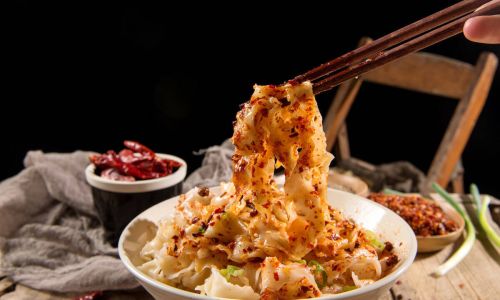
Historically, the northwest was a strategic crossroads for trade and cultural exchange along the ancient Silk Road. This exposure to diverse influences has undoubtedly shaped the local cuisine, including oil-splashed noodles. The dish’s simplicity and adaptability allowed it to evolve, incorporating ingredients and cooking techniques from neighboring cultures, yet retaining its core identity as a hearty, satisfying meal perfect for the region’s harsh winters and long, arduous journeys.
Ingredients and Preparation
The beauty of oil-splashed noodles lies in its simplicity and the quality of its ingredients. At its core, the dish consists of hand-pulled noodles, fresh vegetables, chili peppers, garlic, and a generous splash of fragrant oil. Here’s a closer look at each component and the preparation process:
-
Hand-Pulled Noodles: The noodles are the foundation of oil-splashed noodles. Made from high-quality wheat flour and water, they are kneaded, rested, and then hand-pulled into long, thin strands. This labor-intensive process results in noodles that are chewy, elastic, and capable of absorbing the flavors of the sauce and oil.
-
Vegetables: Fresh vegetables, such as spinach, bok choy, or carrots, are blanched and added to the noodles. These not only add color and nutrition but also balance the dish’s rich, savory flavors with a refreshing crunch.
-
Chili Peppers and Garlic: These are the stars of the show. Dried chili peppers and freshly minced garlic are placed atop the noodles. When the hot oil is poured over them, it releases their aromatic oils, creating a fiery, garlicky fragrance that permeates the entire dish.
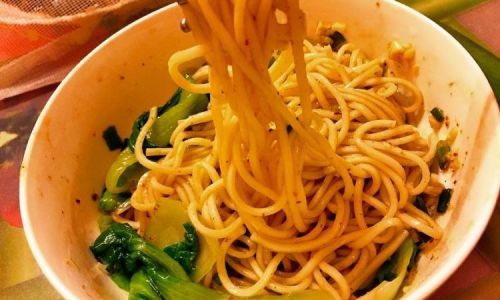
-
Fragrant Oil: The oil used in oil-splashed noodles is typically a blend of vegetable oils, sometimes infused with spices like Sichuan peppercorns or star anise for added complexity. The oil is heated to smoking point and then carefully poured over the chili peppers, garlic, and noodles, creating a burst of flavor and a visual spectacle as the oil sizzles and crackles.
-
Sauces and Seasonings: Soy sauce, vinegar, sesame oil, and a touch of sugar are often added to the noodles to round out the flavors. These ingredients contribute to the dish’s umami, tanginess, and overall balance.
Preparation begins with boiling the noodles until al dente. They are then drained and placed in a large bowl. The vegetables are blanched and added to the noodles. The chili peppers, garlic, and any other seasonings are evenly distributed over the top. Finally, the boiling hot oil is poured over the mixture, creating an instantaneous burst of aroma and flavor.
Regional Variations
Like many traditional Chinese dishes, oil-splashed noodles have undergone regional variations, reflecting the unique culinary preferences and ingredients available in different parts of northwest China.
In Shaanxi, the province known for the Terracotta Army, oil-splashed noodles often feature a thicker, heartier sauce made from soy sauce, vinegar, and a touch of tomato paste. The noodles themselves may be thicker and shorter, resembling biangbiang noodles, a local specialty.
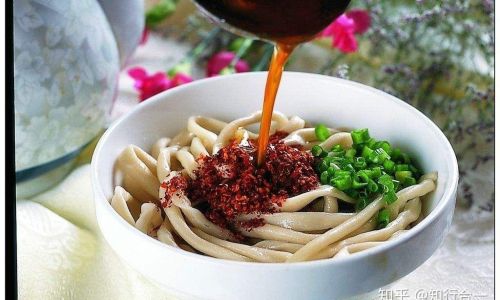
Gansu, famous for its long stretches of the Great Wall and the Silk Road, offers a version where the noodles are topped with a generous amount of minced pork or beef, creating a hearty, meat-based variation. The oil used here may be infused with local spices like cumin and coriander, adding layers of complexity to the dish.
Ningxia, known for its fertile plains and rich agricultural produce, incorporates local ingredients like wolfberries and mushrooms into its oil-splashed noodles, giving the dish a unique, earthy flavor.
Qinghai and Xinjiang, with their Muslim-majority populations, offer halal versions featuring lamb or beef, as well as unique spices like cumin and paprika, reflecting the region’s Central Asian influences.
Cultural Significance
Oil-splashed noodles are more than just a meal; they are deeply embedded in the cultural fabric of northwest China. They are a symbol of hospitality, often served to guests as a welcome gesture or during special occasions. The dish’s preparation and sharing are rituals that bond families and communities, creating a sense of belonging and shared identity.
Moreover, oil-splashed noodles are a testament to the ingenuity and resourcefulness of northwest China’s inhabitants. In a region where resources can be scarce, this dish showcases how simple, locally sourced ingredients can be transformed into something extraordinary.
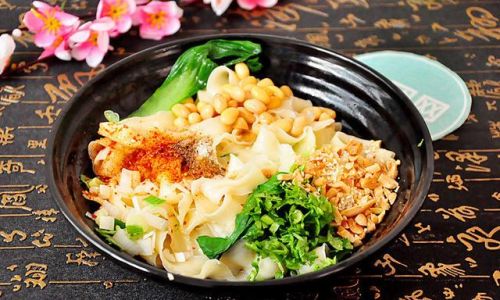
In recent years, as China’s culinary heritage has gained global recognition, oil-splashed noodles have become a popular export, featured in restaurants and street food stalls worldwide. This international exposure has not only introduced the dish to new audiences but also sparked a renewed interest in preserving and promoting northwest China’s culinary traditions.
Conclusion
Oil-splashed noodles are a culinary gem that embodies the spirit of northwest China. Their simple yet profound flavors, the labor-intensive preparation, and the cultural significance they hold make them a dish worth celebrating. As China continues to embrace its culinary diversity and share it with the world, oil-splashed noodles stand as a proud ambassador of northwest China’s rich culinary heritage. Whether enjoyed in the heart of Shaanxi, the bustling streets of Xi’an, or a cozy restaurant halfway around the globe, oil-splashed noodles offer a taste of northwest China’s authenticity, warmth, and culinary excellence.
In a world where fast food and convenience often reign, oil-splashed noodles remind us of the joy and satisfaction that come from slow, thoughtful cooking and the appreciation of quality ingredients. They are a reminder of the power of food to connect people, cultures, and generations, and a testament to the enduring appeal of traditional Chinese cuisine.
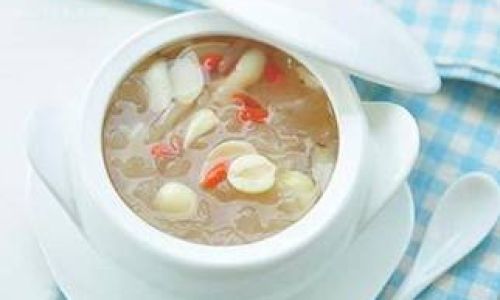




0 comments